
As wee little Explorer Genes in 1989, Greg and Mandy certainly had one thing in common as they watched Indiana Jones emerge into the ancient city of Petra’s Treasury in The Last Crusade… how can such a magical place actually exist and how awesome would it be to see it in person? It took 30 years, but we finally made it happen, and we also threw in some incredible ruins, castles, ancient mosaics, and otherworldly nature in the process. And not to forget, some really amazing and genuine people along the way.
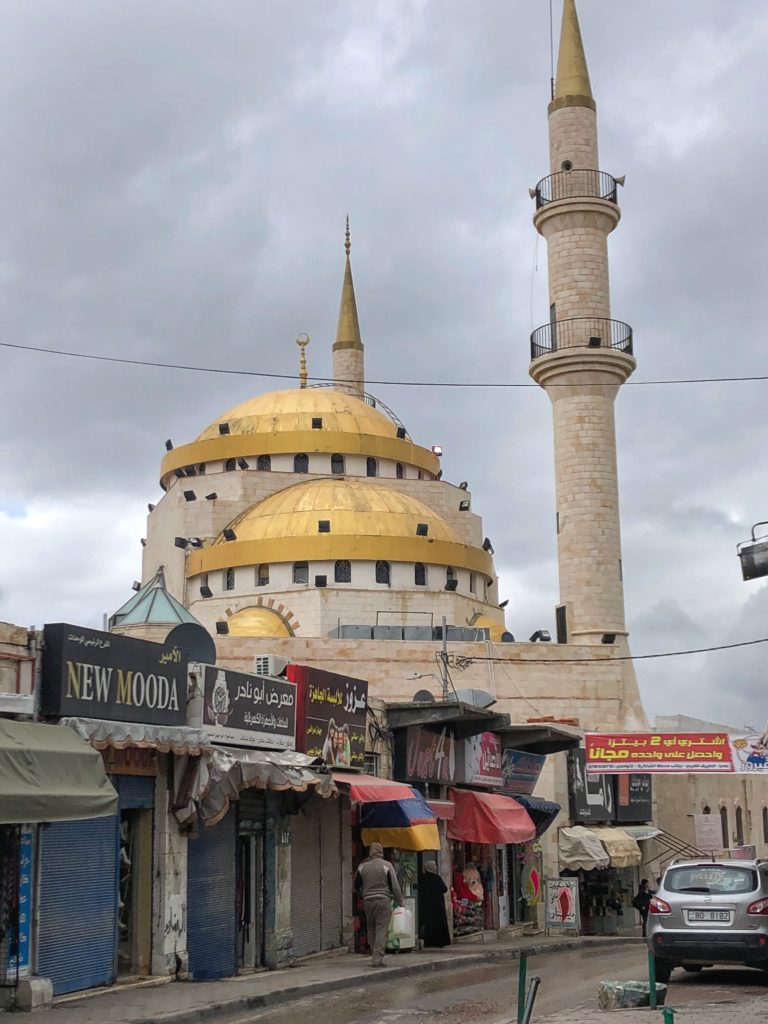
Madaba
Our Jordan journey began 10:30 pm when we landed at the international airport in Amman. In an adrenaline-filled travel fog, we quickly picked up our car, visited the ATM for some Jordanian Dinars, and drove 25 minutes to the town of Madaba. We learned quickly to slow down and keep an eye out for the random, un-signed, and unmarked speed bumps on the roadways. Also we learned that being in the Middle East does not equal warm weather… it was 36F (3C) when we came out of the airport!! Later, the next morning waking up to our first Islamic Call to Prayer dreamily echoing through the city streets at 5:00 A.m. was a surreal reminder of being in an Islamic country, and a lovely way to welcome the day. Out and about in the chilly air we headed into Madaba to check out the sights, including this lovely gold domed mosque and shopping area.
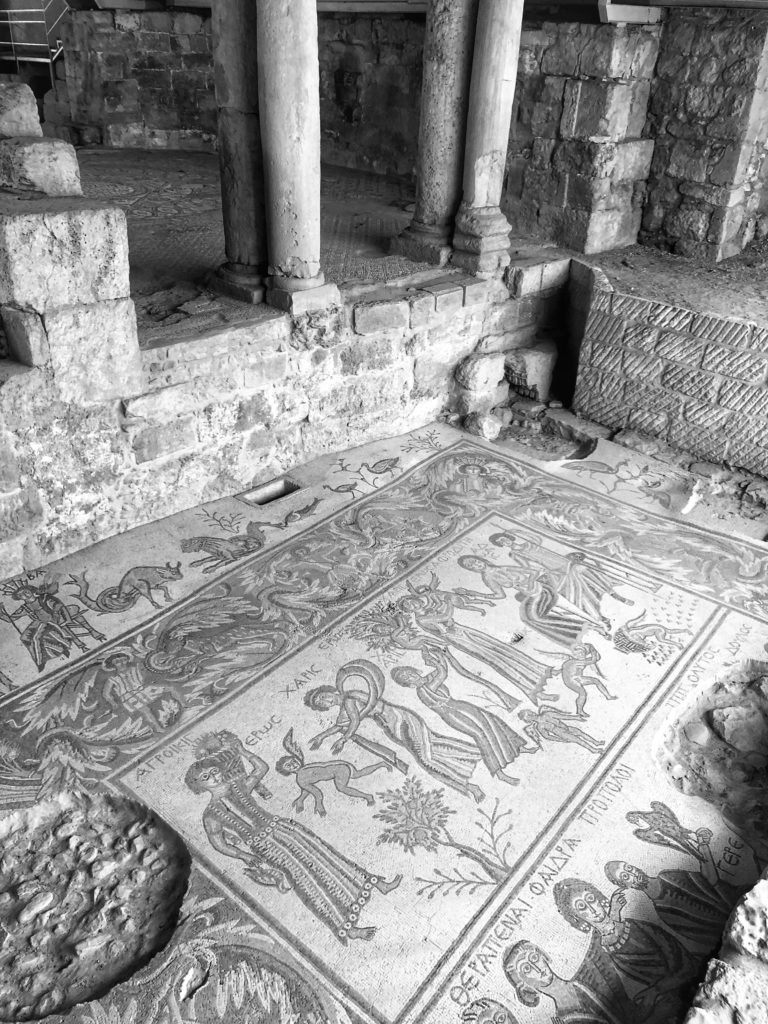
The best way to travel in Jordan is to get a Jordan Pass. It costs about $100 and provides access to 40 sites, including Petra, and your Jordan visa. The savings is undeniably worth it because visiting Petra and buying a ticket is $70, further the visa is $56. Because of this pass, we also got to visit several other sites we probably wouldn’t have gone to including the amazing archeological parks and intricately preserved mosaics in Madaba. Most are from around 7th Century AD, during the Byzantine Era.

This mosaic map in St. George’s Church is a truly unique treasure and an incredibly intricate display of early Christian culture in Jordan. It represents a one-of-a-kind-find, and is the oldest map of Palestine and the early Christian Holy Land in existence from 560 AD depicting all major biblical sites in the Middle East. The map was only discovered in the 1920’s, when a Christian group of who had settled on the land began excavating the area to build upon it. Imagine making this discovery while digging the foundation for your home. All captions are written in Greek. In this picture you can see the Dead Sea, Jerusalem, Jordan River, Lot’s Cave, and Bethlehem.
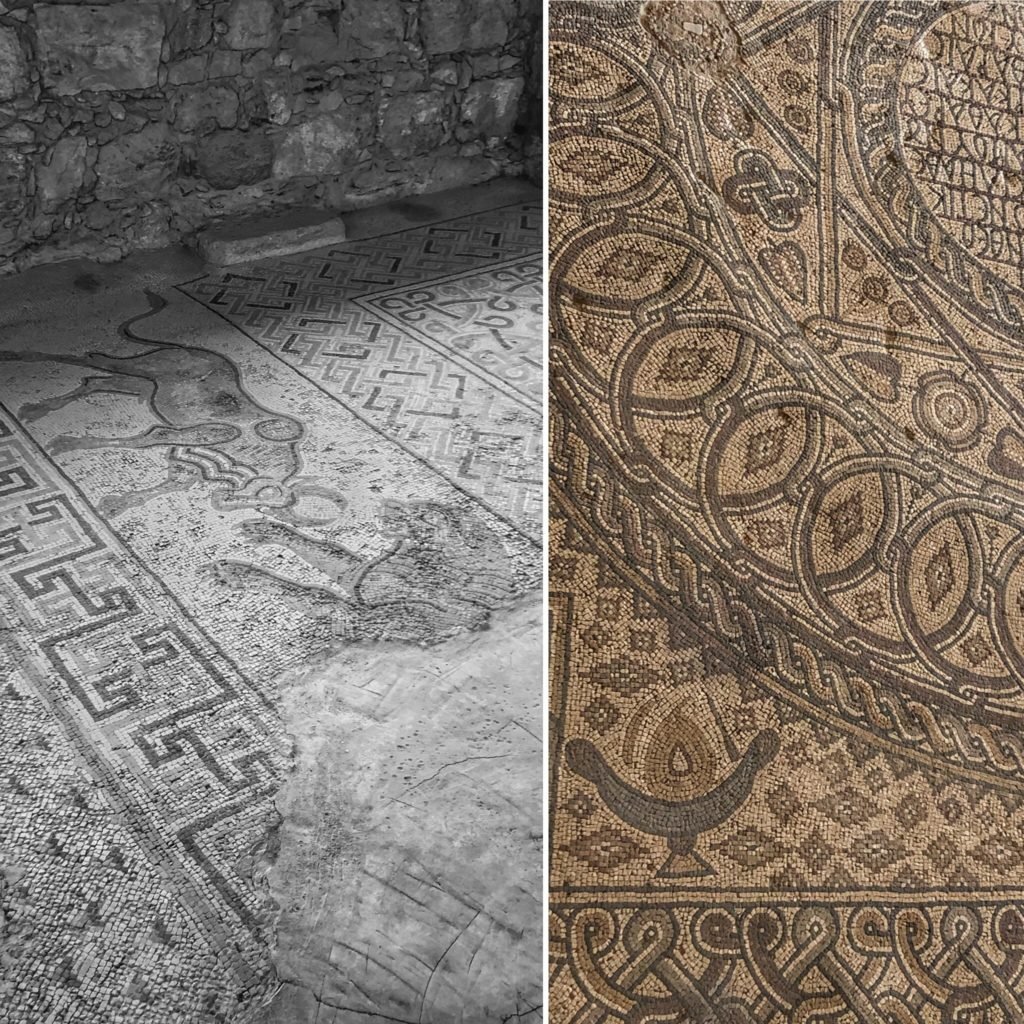
Other mosaics throughout Madaba. Notice some include depictions of lions, elephants and bears. Believe it or not, all these animals once roamed the land in what is now Jordan before they were hunted out.
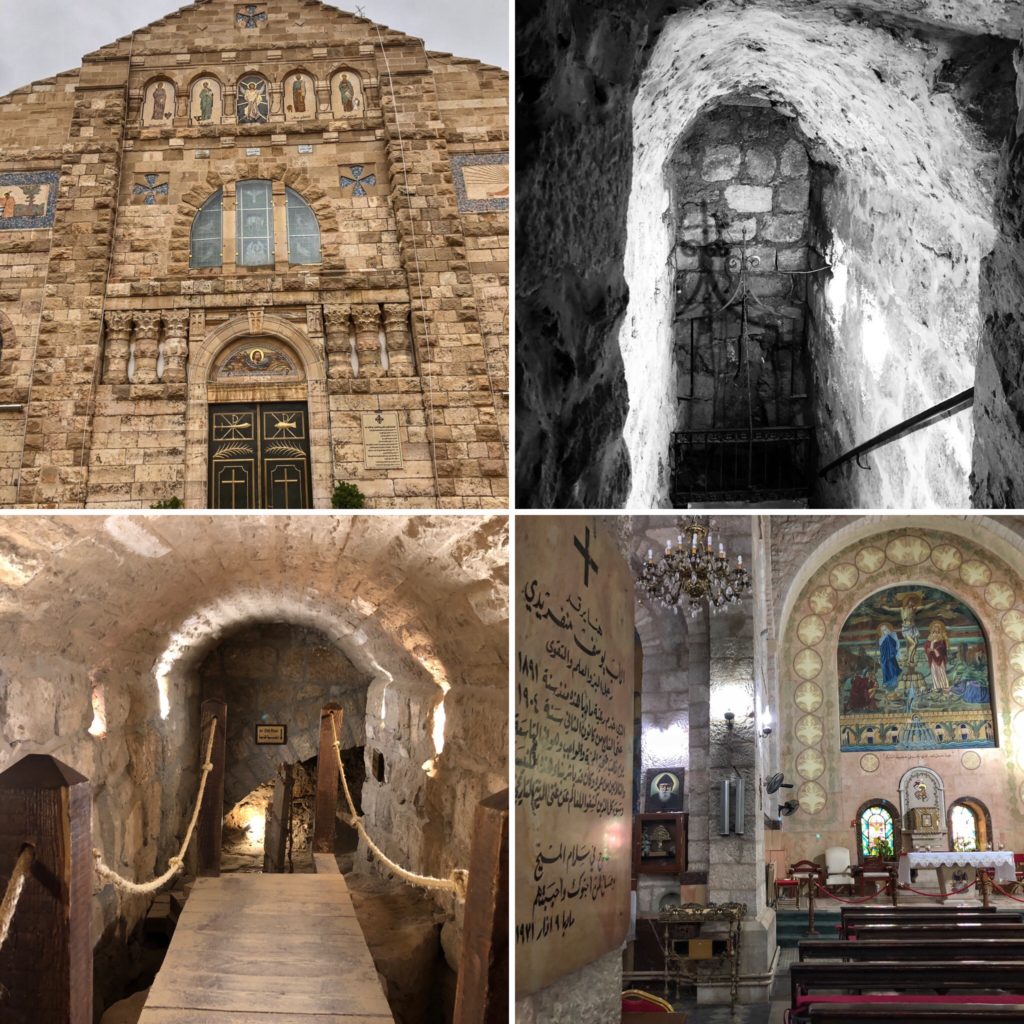
In a country that is 98% Islamic, Madaba has one of Jordan’s largest Christian communities. In addition to a lovely sanctuary, the Church of John the Baptist, has a well dating back 3000 years (top right), and inside secret underground passageways snake under the church floors showing you ancient Roman ruins, and also a vertigo-inducing tower.

Continuing on, we began our road trip of the King’s Highway, which actually gets its name from being built upon a critically important ancient trading and caravan route that stretched from Egypt to Turkey. Far from a highway, a double lane road winds its way through the land. We stopped at this pullover to check out a Bedouin tea/coffee stand… and the view of the desert floor far far below us.
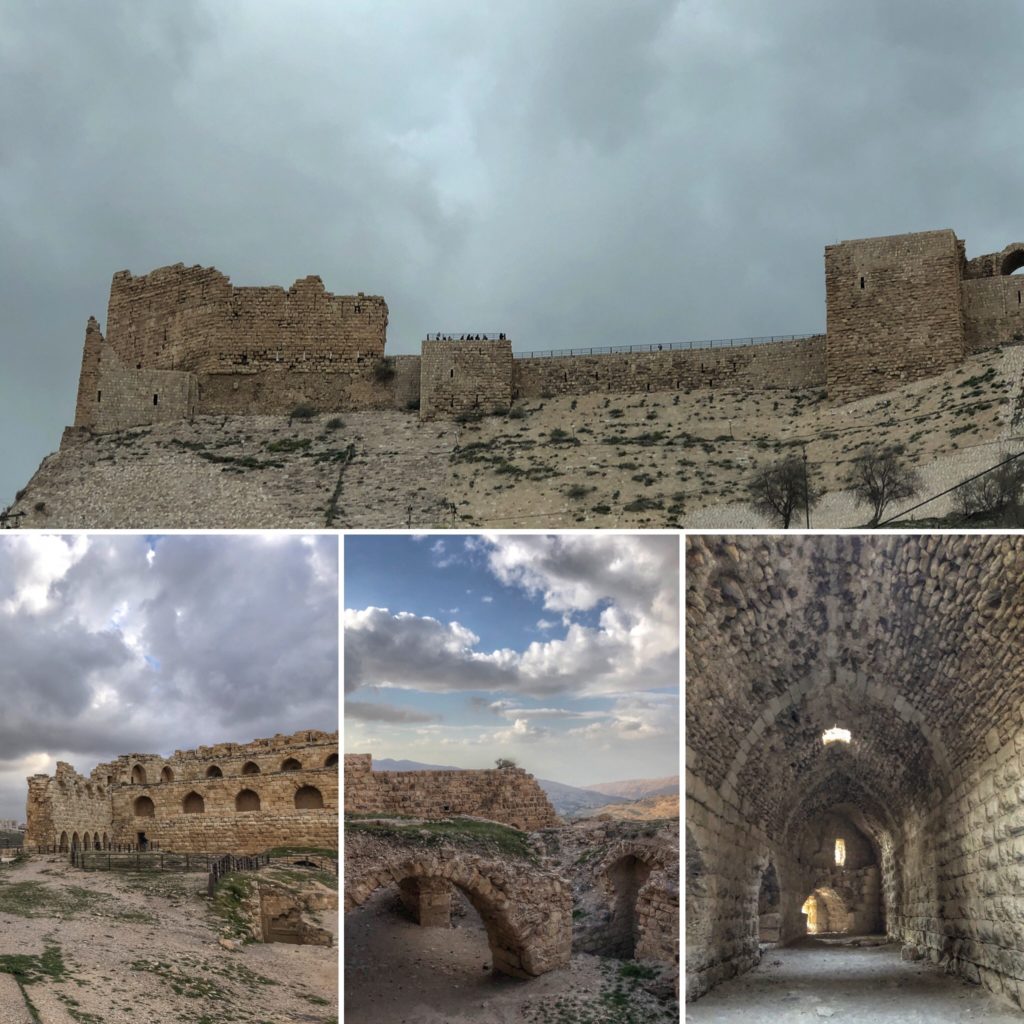
Karak
Next we visited the 1142 Crusader Castle of Karak. This fortified castle that dominates the town was a place of legend in battles between the Christian Crusaders and Islamic armies of Saladin. It is mentioned in the Bible several times as Kir. Today much of it is in ruins but it was so fun to roam through the dark hallways and explore hidden tunnels to imagine what it was!
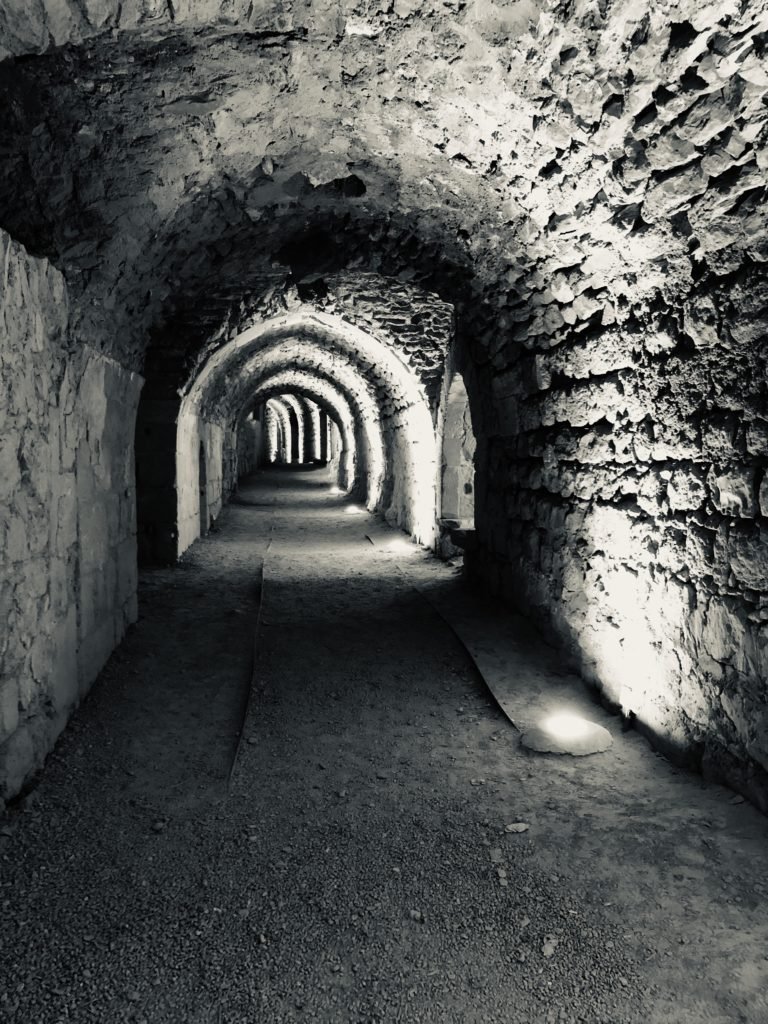
The arches were the most noteworthy feature and meant to last. Pretty sure no architecture of today will be around in 900 years!! After this, we checked into Cairwan Hotel ($22) for a warm room and bunk beds and a really delicious cinnamon tea nightcap.

Dana
The next day we tried to go to a hot spring off the King’s Highway and sadly there had been a landslide due to the recent torrential downpour the night before, so we couldn’t go. 🙁 Instead, we headed to the charming 15th Century Stone village of Dana perched thousands of feet up on a cliff overlooking some wild and beautiful mountain terrain. If it hadn’t been raining sideways, and bone-chilling wind, we probably would have hung out longer to check out the very tempting looking hiking opportunities in the adjacent nature reserve.
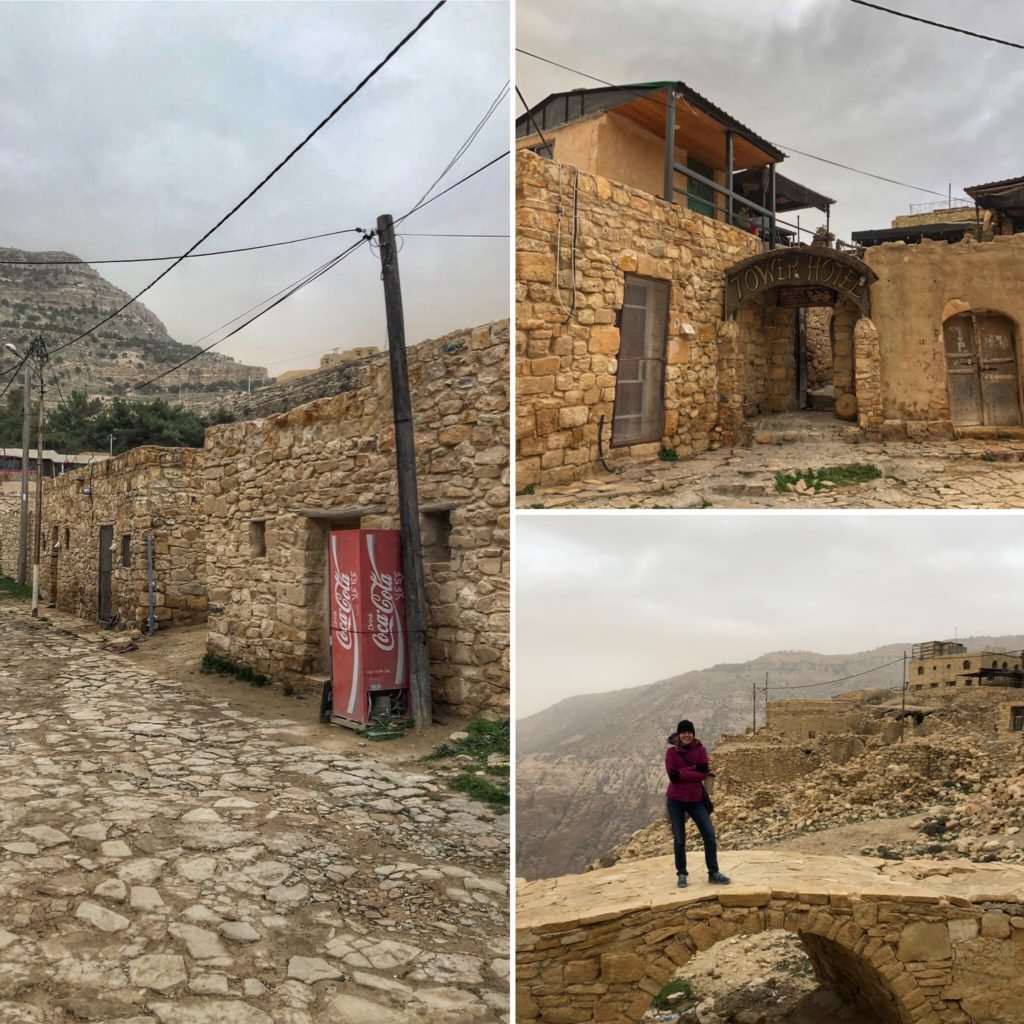
While exploring the village of Dana, we were kindly invited to have tea at the Tower Hotel to have a break from the cold. It was so nice to sit down and talk to the hotel owner and manager and get to know them and share our stories. If we could have stayed the night there we would have… despite the cold outside, it was amazingly peaceful in Dana and the Tower Hotel looked super cute! The offers of tea happened many times to us in Jordan, regularly given free food in stores, or just welcomed with big huge smiles. In short, the people of Jordan are amazing, and so generous with their hospitality!
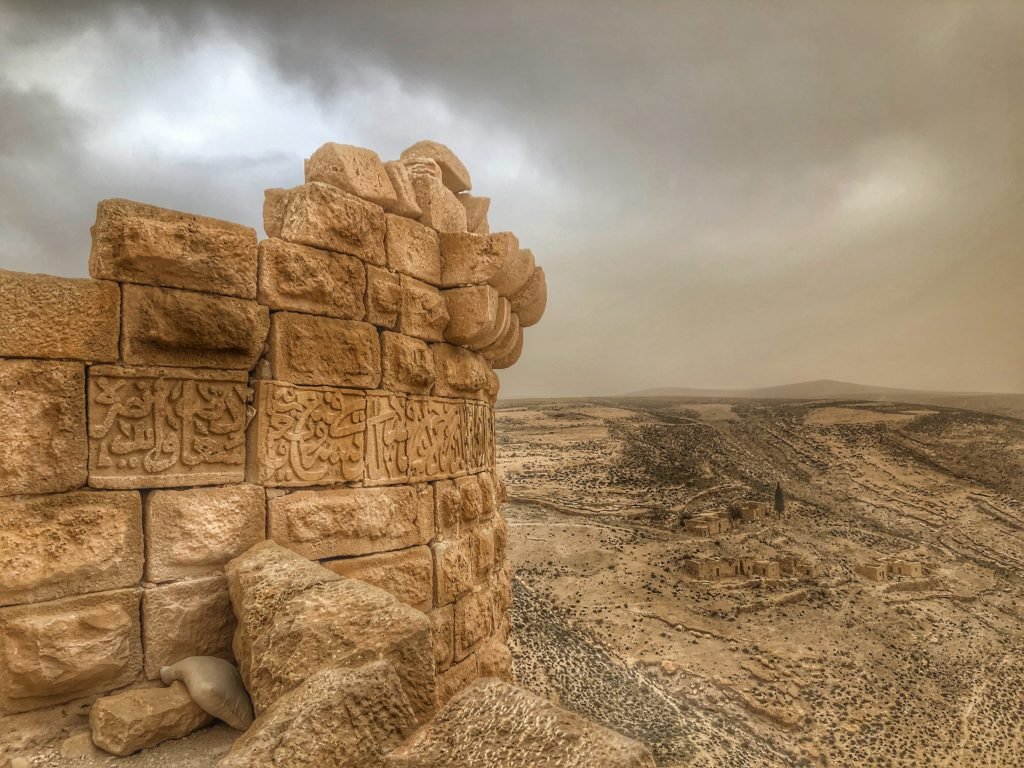
Shobak
Visiting another significant crusader castle in the small village of Shobak along the King’s Road. Built in 1115. Here on the castle walls, you can still see Quranic inscriptions from around the time of Saladin. By the way, check out the yellow sky in this unedited picture. That’s what a dust storm looks like in the desert! It was eerie.

In Wadi Musa, the town nearest to the ruins of Petra, we checked into our Airbnb ($36) and were greeted by our wonderful Bedouin host family with Arabic coffee made with cardamom. In our room we found a gigantic bed, and a sofa big enough to hold the whole village in the living room. It was made of 8 4’ sections and isn’t even all pictured!
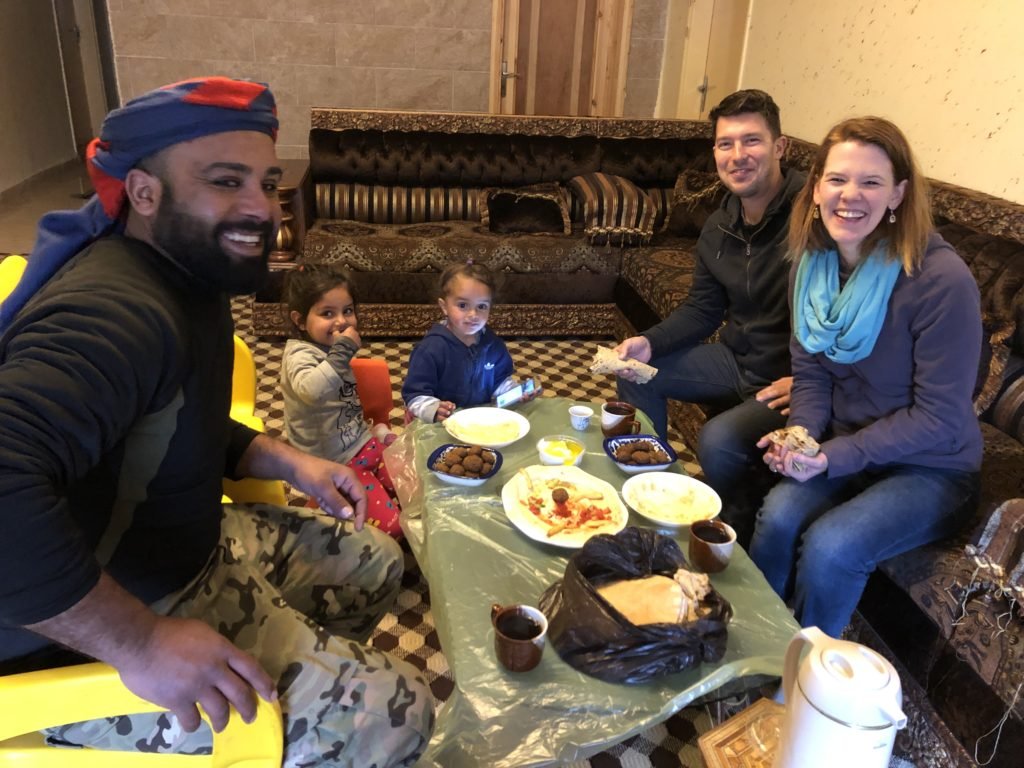
The next morning we had a delicious breakfast consisting of hummus, falafel, eggs, and yogurt which we shared with (Dad) Twfeeq and his adorable family. They were beyond kind to us and we loved staying in their home. Although it was booked through AirBnB we felt as though we were doing a traditional home stay… Not to mention all the neighbors who wanted to get to know us every time we went outside, we got shouts from across the street or greetings of “hello, how are you?” And “welcome!” The girl next door was even a “huge Seattle Seahawks” fan.

Petra
We had two days to explore the remarkable 2000-year-old Nabatean city of Petra and one of the New 7 Wonders of the Ancient World. It’s hard to imagine that a city can be built from carved rock facades, but when you glimpse Petra firsthand it’s clear… this was an ancient and functional city of rock in the desert. And as you can see, getting there at 6:30 am was well worth it for dodging crowds and getting epic pictures. After parking, it was time to amble our way through the serpentine Siq, or canyon. Surprisingly, it is not actually a canyon. It was actually formed by two tectonic plates that split the ground apart long ago. You can see this in places where one side of the Siq perfectly matches the other. This is one of three ways to enter Petra and is the most traditional as the other two require guides.
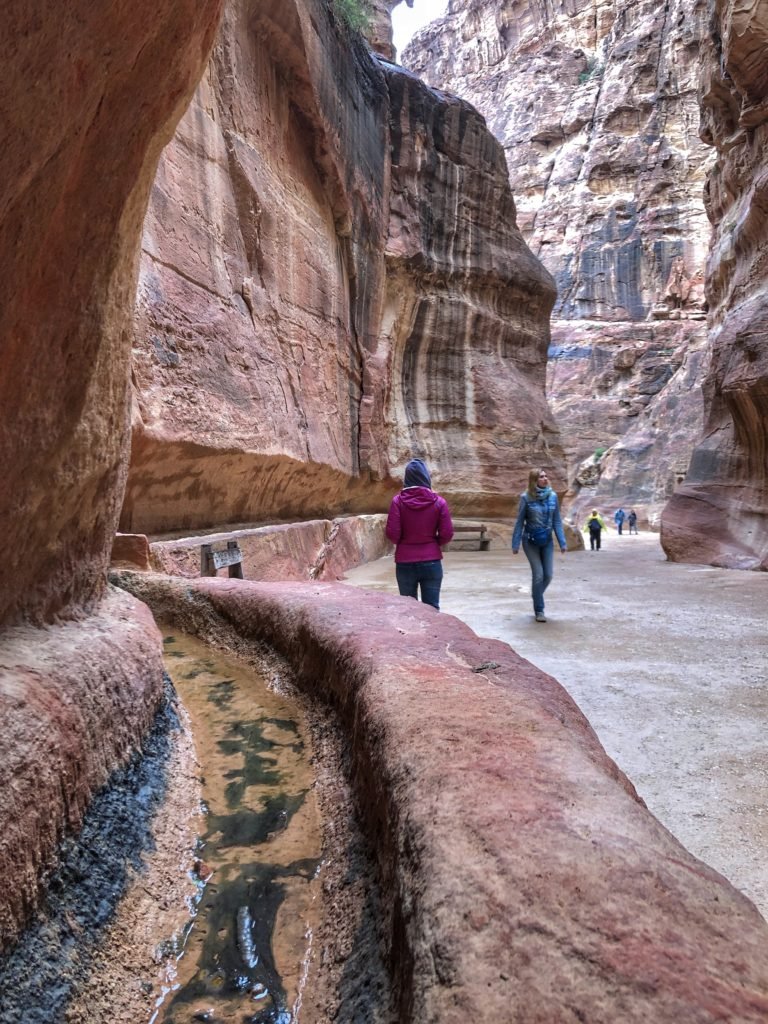
Want to know how they got water? The Nabateans were expect hydrologic engineers for their time. They devised and intricate system of cisterns, reservoirs, and later in the day we noticed the clever water channels cut into the canyon walls which brought and distributed water in the city.
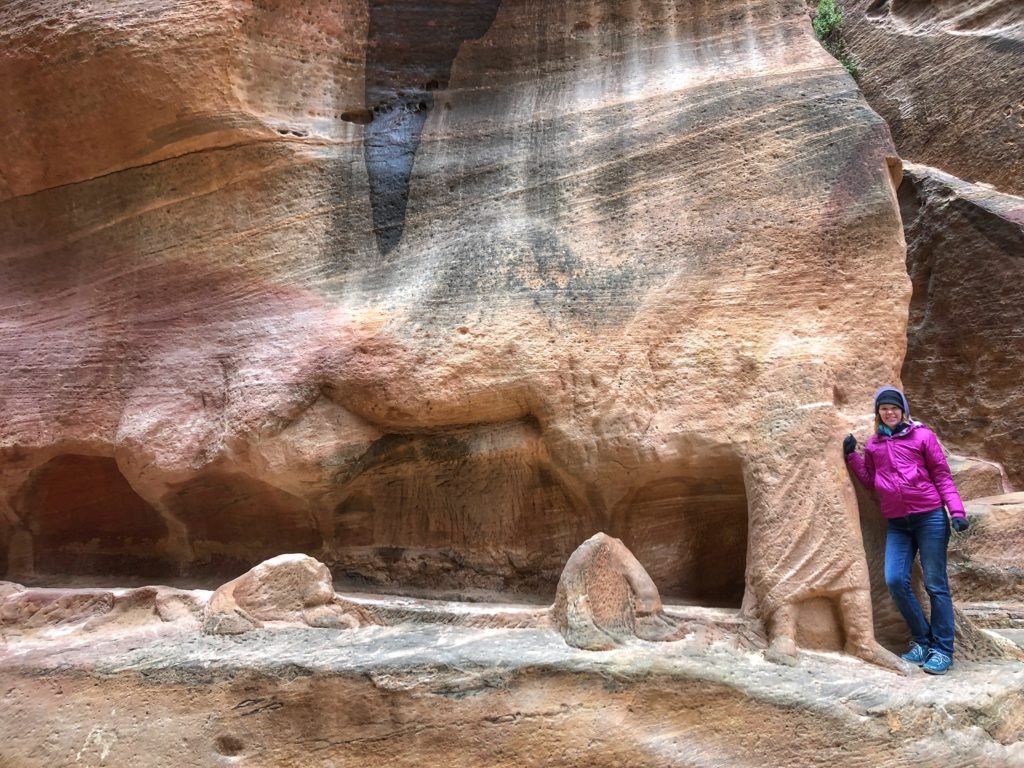
A weathered carving of a camel and a caravan man. The water channel continues to flow underneath in a channel.
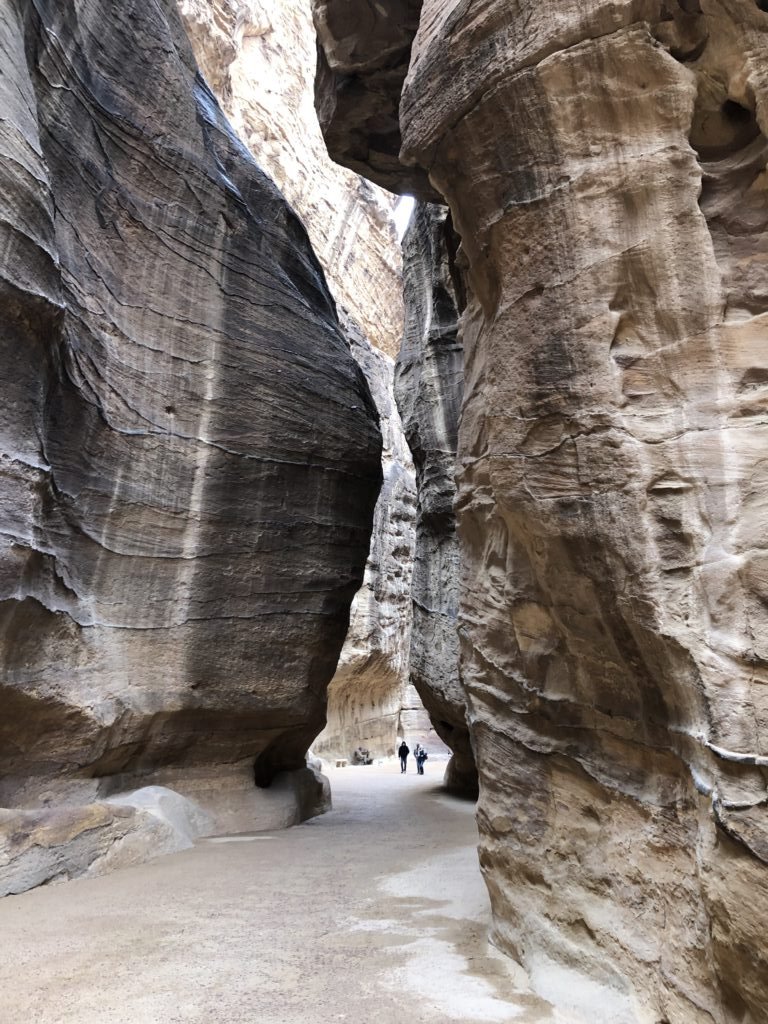
Another Siq shot.
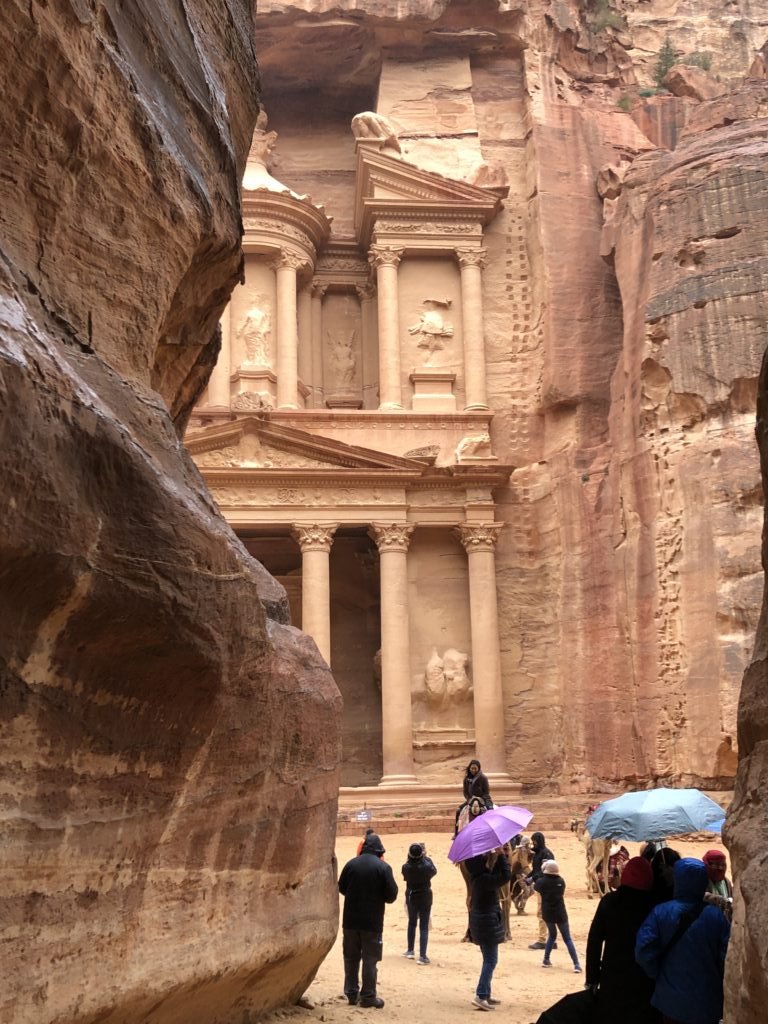
The much anticipated National Geographic shot you get when you first spot the Treasury after slithering through the Siq. Pretty impossible to get this one without the people in your shot! (Unless you’re Dr. Jones, naturally.)

More shots of the treasury…and the moment where you become enamored with Petra. This magnificent structure was chiseled from the rock from the top down. An incredible 2000 years ago?! Can you even imagine how difficult that would be to make everything so symmetrical on this scale? The Treasury ruin was actually the tomb of the Nabatean King Aretas III, but got its name because supposedly some Egyptian pharaoh hid his gold there while going after the Israelites.

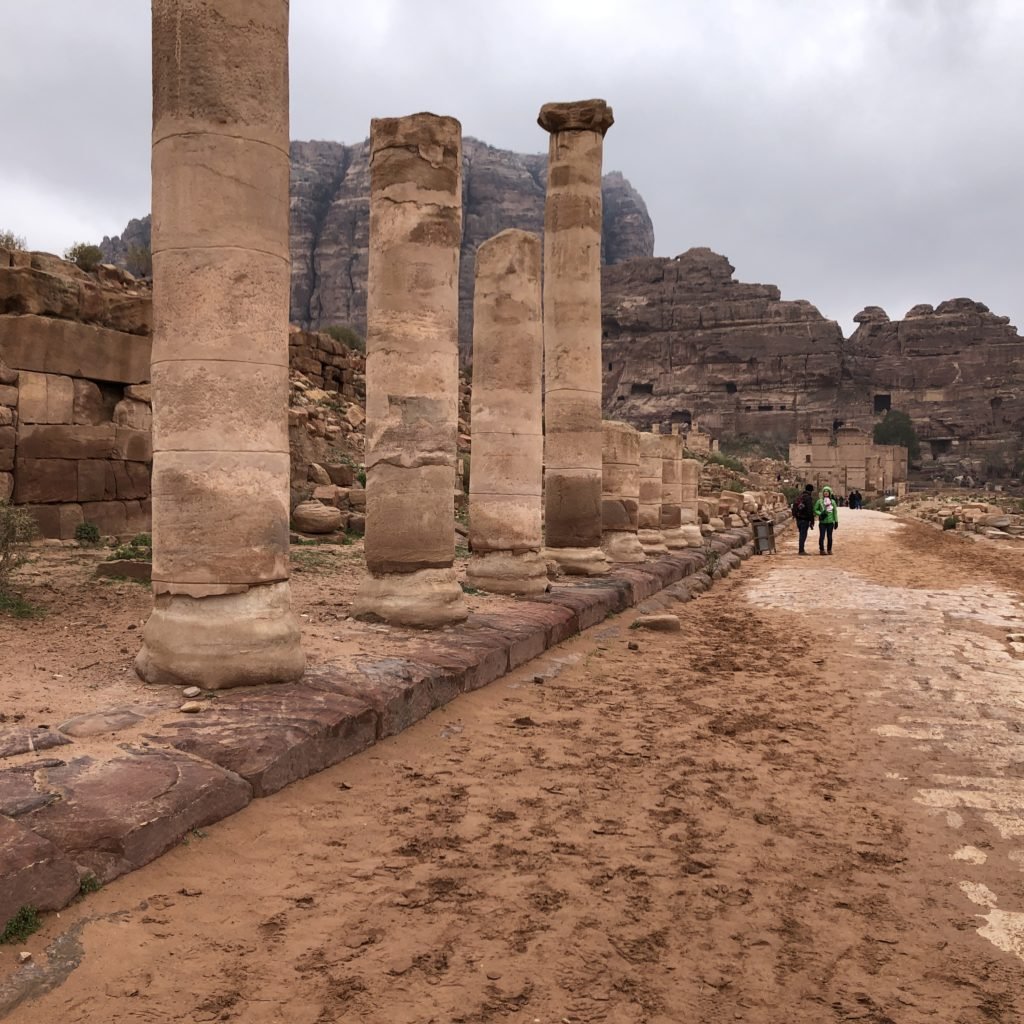
This turns into the colonnaded street, which actually marks the center of the Ancient City. Built in 106 AD, it follows a standard Roman pattern built up after Rome conquered Petra.
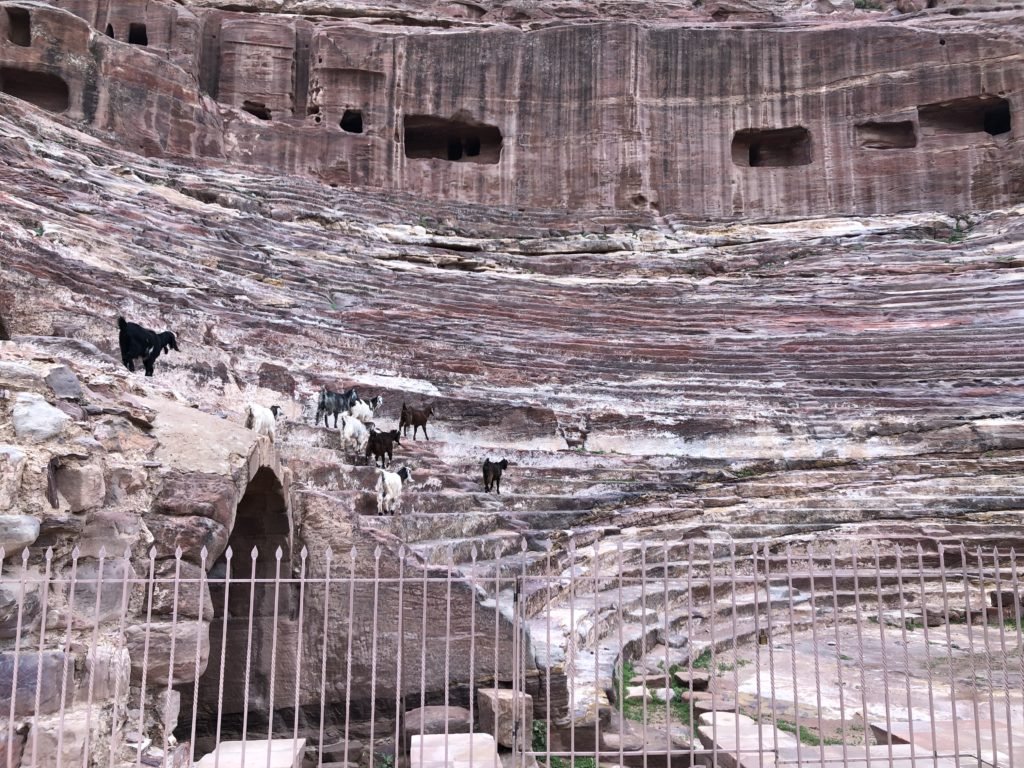
While in this area, you’ll also see the amphitheater which was also chiseled of rock by the Nabateans and later enhanced to seat over 8,500 people by the Romans who plowed in to takeover around 100 AD. It was most likely first used for religious reasons and then for entertainment, because nobody does a good tragic play like the Romans. Today the entertainment consists of watching the plentiful goats frolick and baaa their path over the steps.
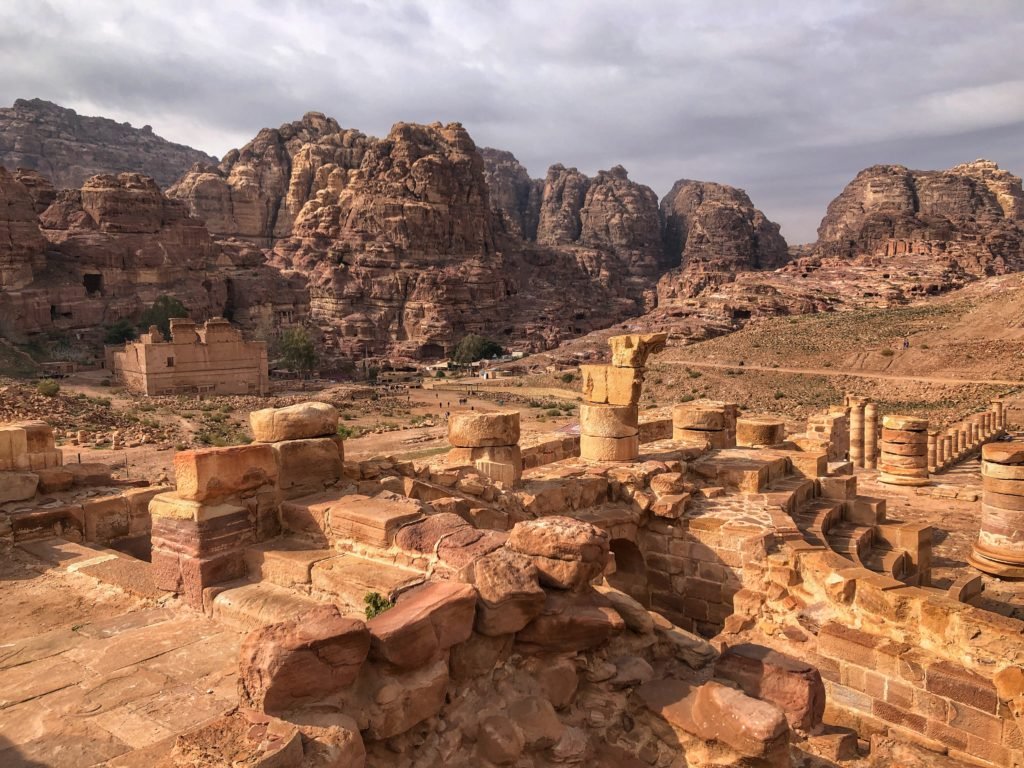
Put your walking shoes on because Petra is huge! Both days we clocked over 25,000 steps. You also have the option to take horse, camel, or donkey rides if that much walking sounds miserable to you. On the first day, we decided to start by walking the full length of the city to get to the monastery (about 5.5k) Don’t be fooled…you don’t have to have a guide to get to most places in Petra, but of course it does benefit the locals and “guides are recommended.” Also, if you do hire a guide, don’t take the first offer from an ad hoc guide or a pushy kid a foot shorter than you! As you climb up from the main city toward the monastery, there are plenty of vendors to gawk at along the way to either entertain, or distract you. In the background, Qasr Al Bint structure was built around 40 BC by the Nabateans. Once 23 meters high, it was probably the main worship place. The Nabateans were polytheistic as was trendy at the time, and worshiped many gods, including Greco-Roman ones.
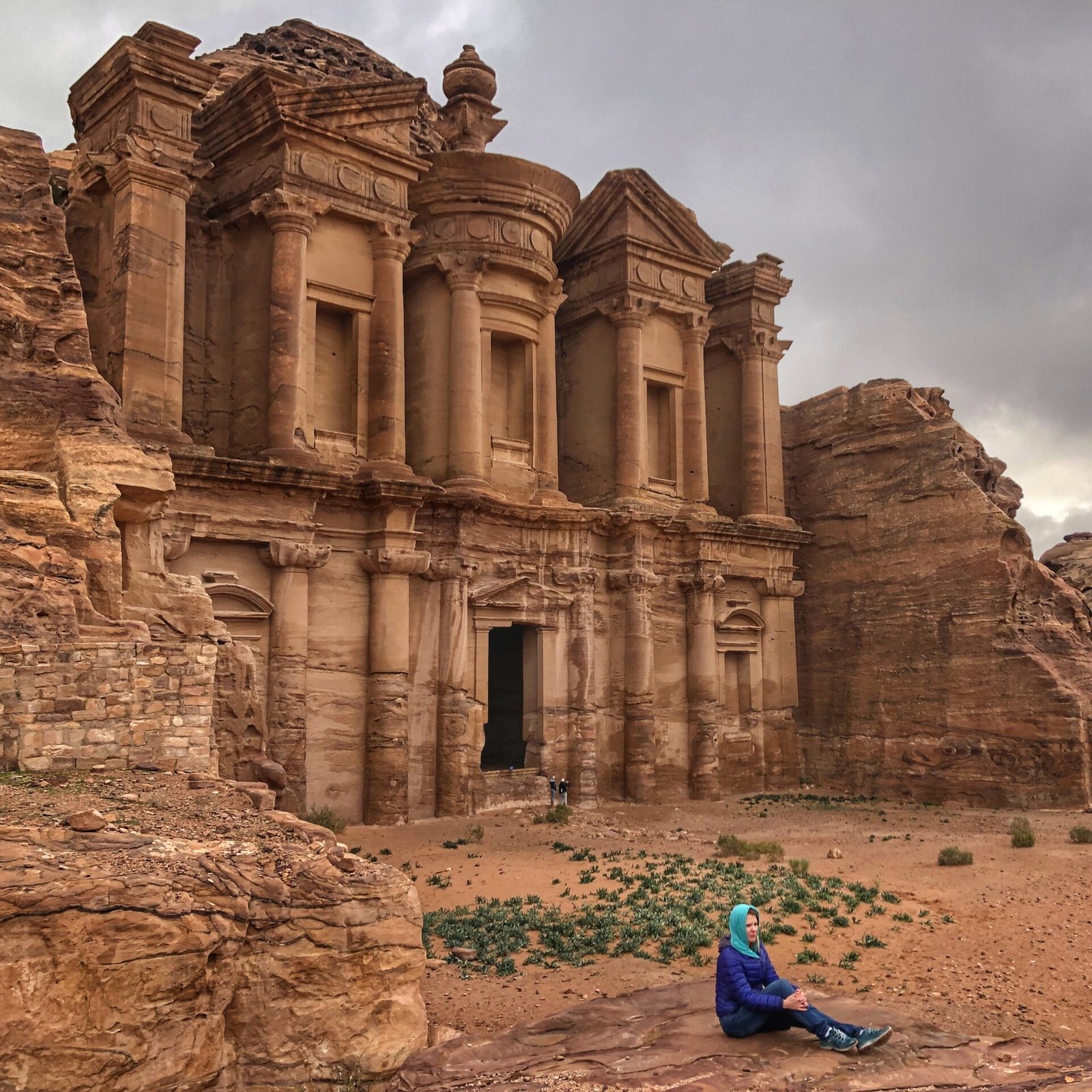
Once we made it to the “hidden” monastery built in 3rd Century BC, we were delighted with very few crowds. The extra effort to walk the 5.5k really paid off! It is similar to the Treasury in design but much bigger, about 148’ or 13 modern day stories tall! Again, incredibly carved from the rock from the top down.
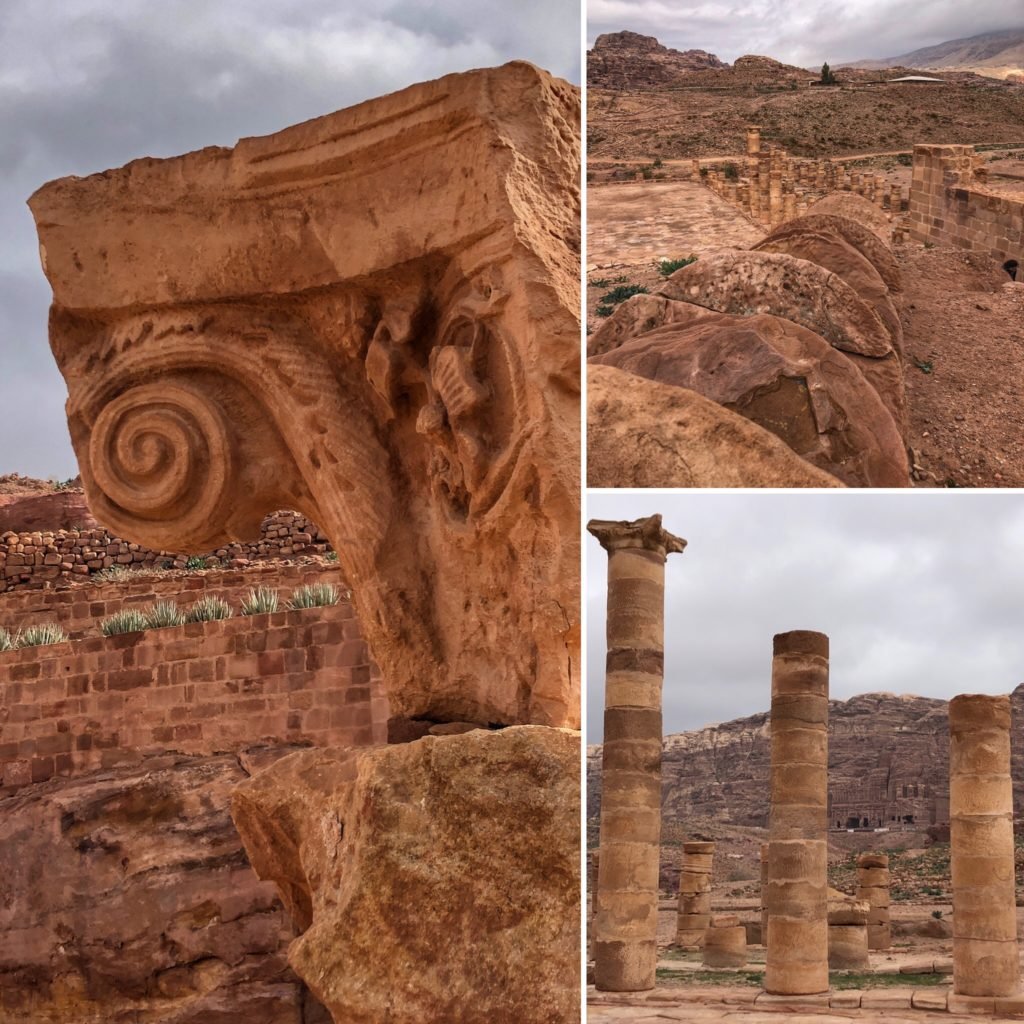
Trotting back into Petra downtown, we stop by the Great Temple. It was incredible to see the fallen Roman columns and how they were built by placing one humongous stone circle slab on top of another.
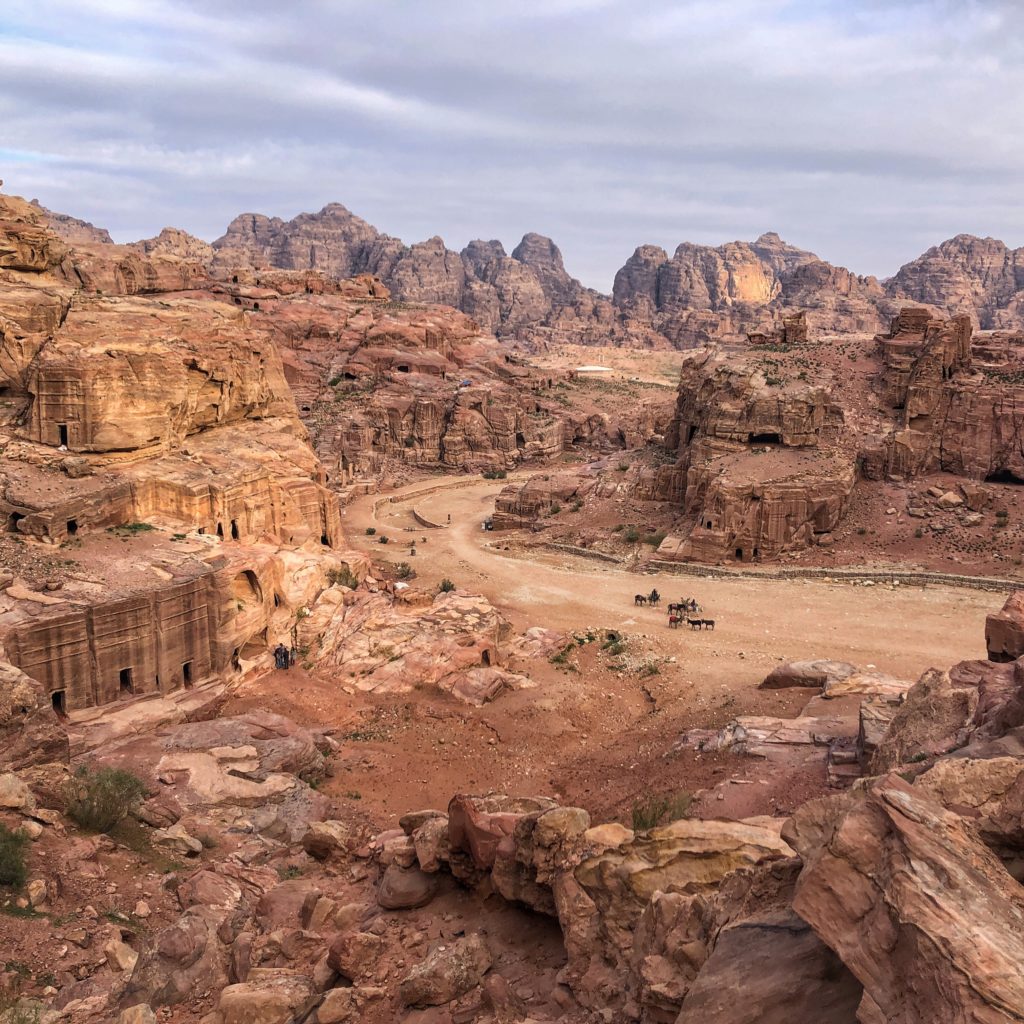
A view of the city center from the steps going up to the High Place of Sacrifice.

This group of buildings is called the Royal Tombs, the most impressive burial places in Petra.
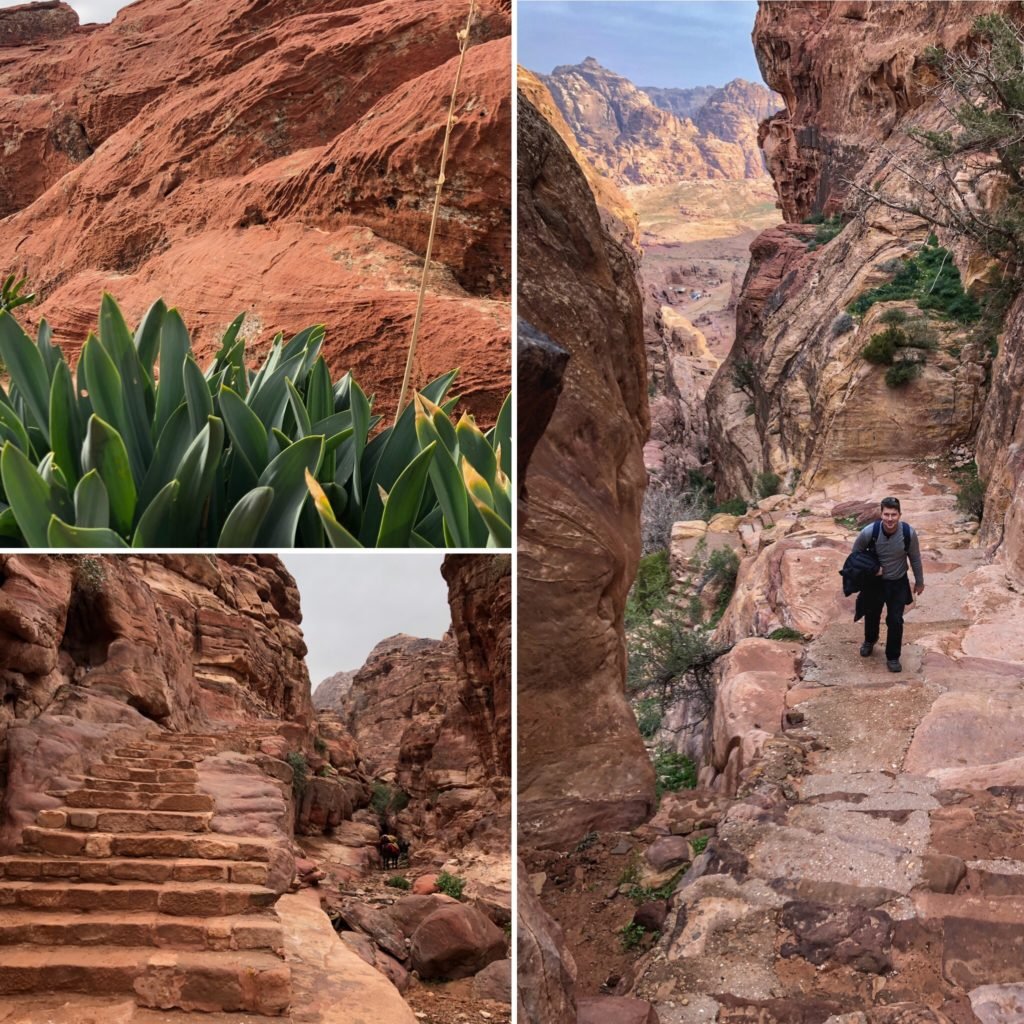
You can take trail that winds up hundreds and hundreds of stone stairs to the top of the canyon and behind tombs…
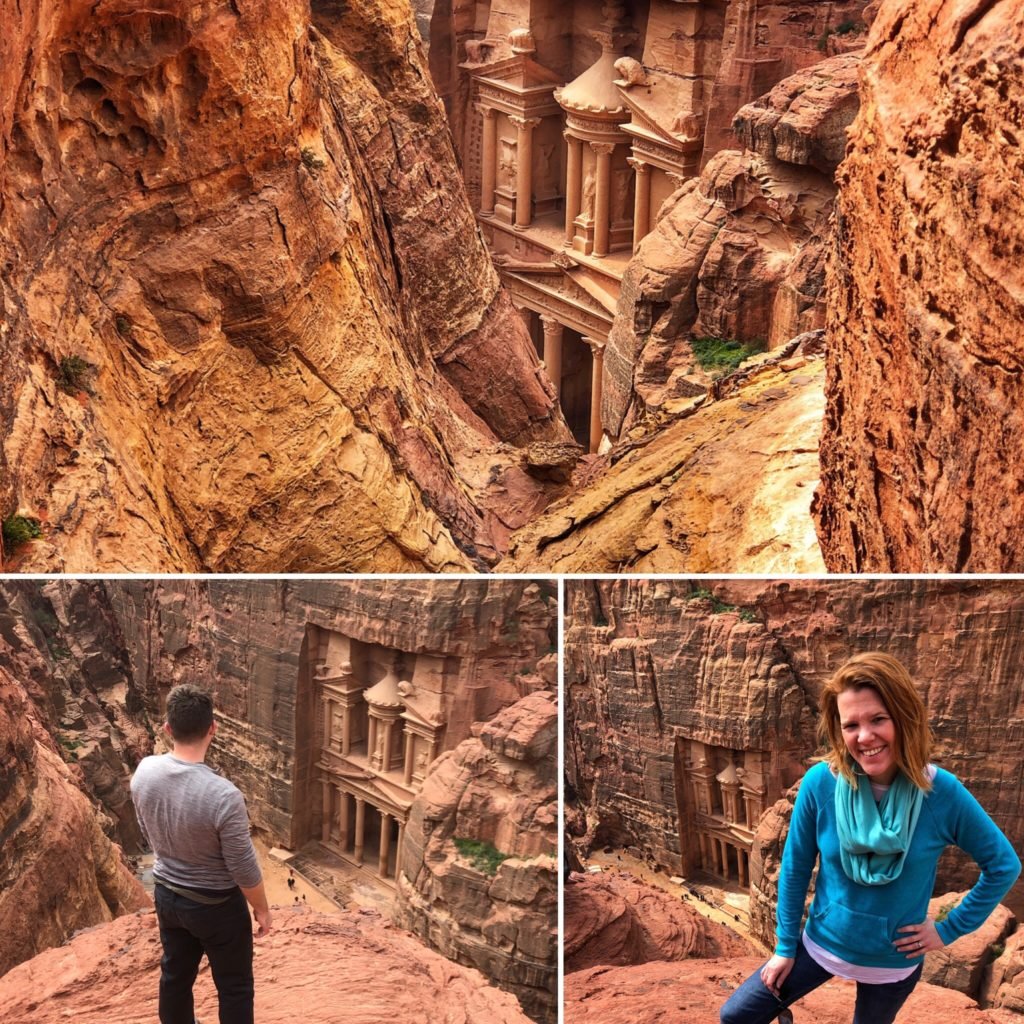
…to reach this unbelievably beautiful top down view of the Treasury

And included with the effort is an excellent puppy welcoming party!
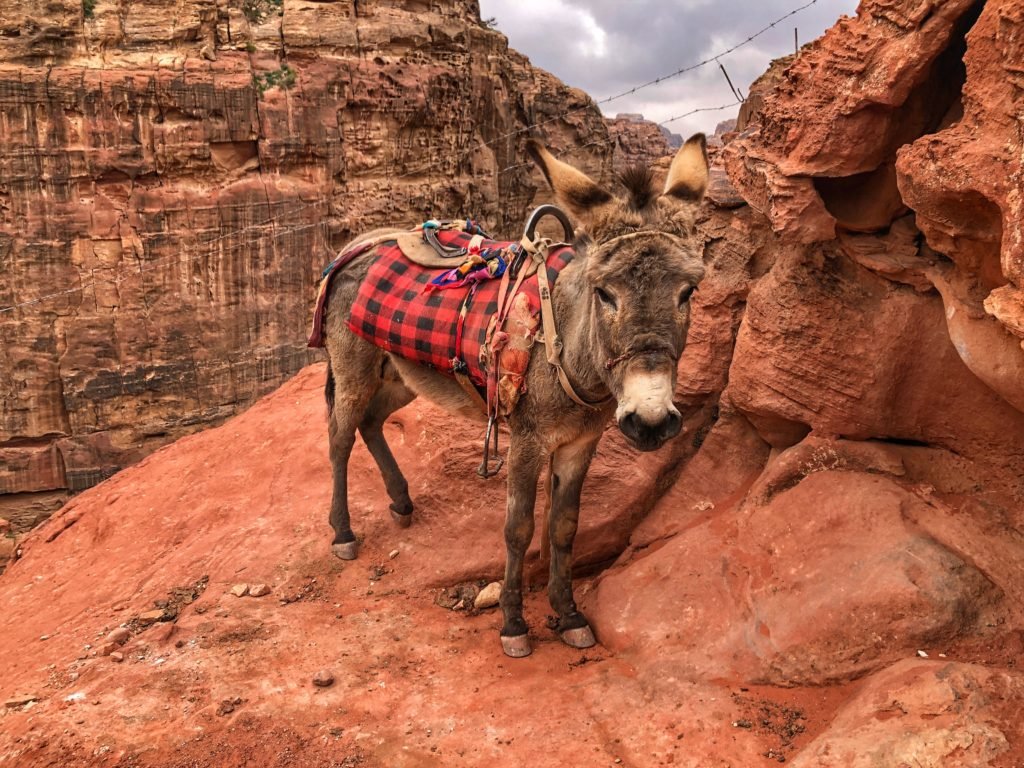
This donkey was hanging out at the top. He seemed content, but we really didn’t like seeing how donkeys were being mistreated elsewhere in the city. We personally would avoid riding one for this reason.
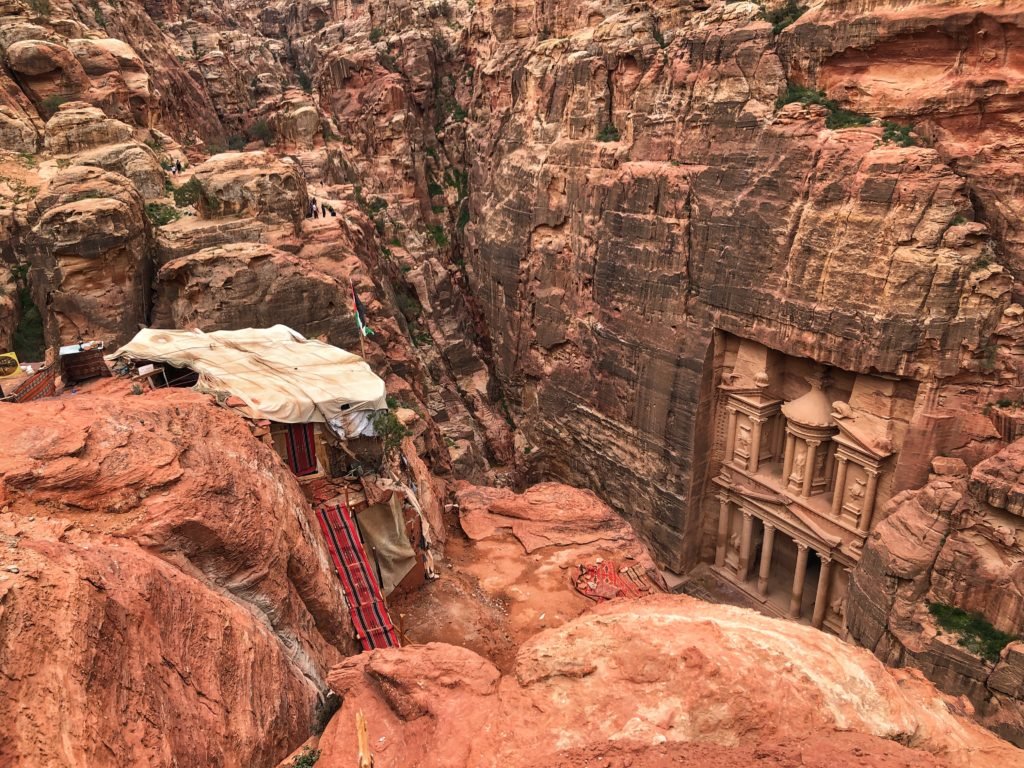
A Bedouin tent was set up at the end of the view selling tea and coffee. Not sure how we feel about this commercial use for such an epic place…

A spectacular view of the theatre from above. You can see how big it is from this angle.
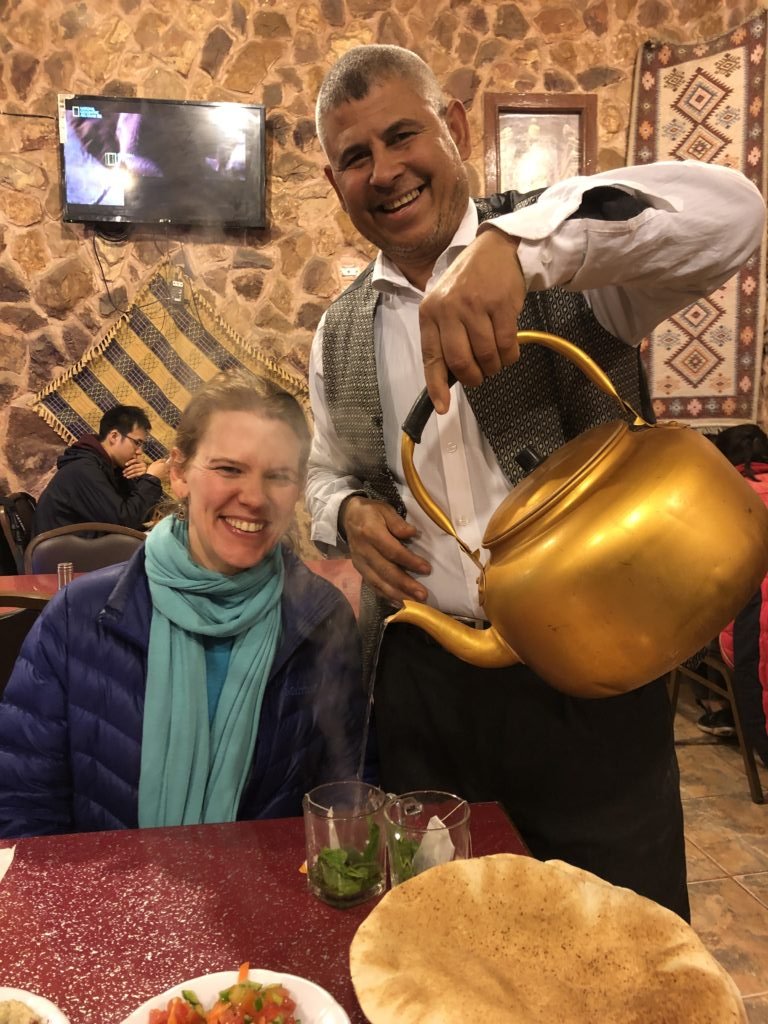
Back in town, we had to get our fix of Jordanian food. We particularly enjoyed this restaurant, Reem Beladi, great food and a hilarious server named Mohammed, and the mint tea.
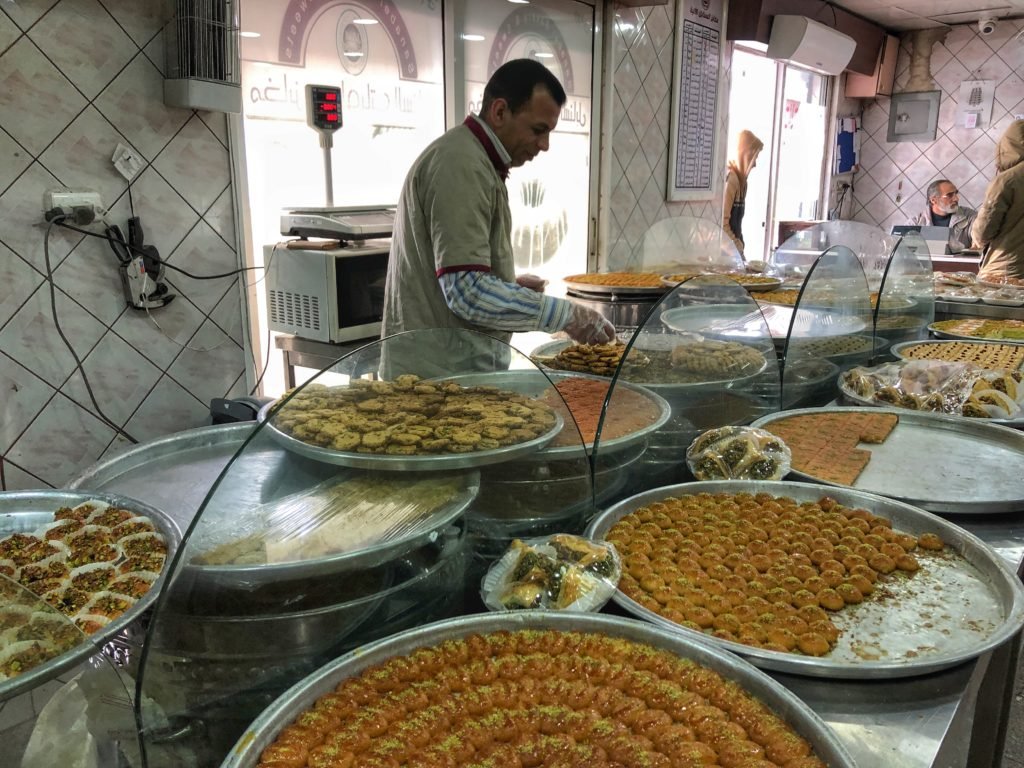
Also, we were big fans of the Arabian sweet shops. Since alcohol is often a no-go in Jordan, we’ve learned sugar is the locals favorite vice. Oozing with flaky pastry crusts, nuts, cinnamon, honey, custards and syrup, they are to die for! Not to mention they kept “forcing” free samples at us.
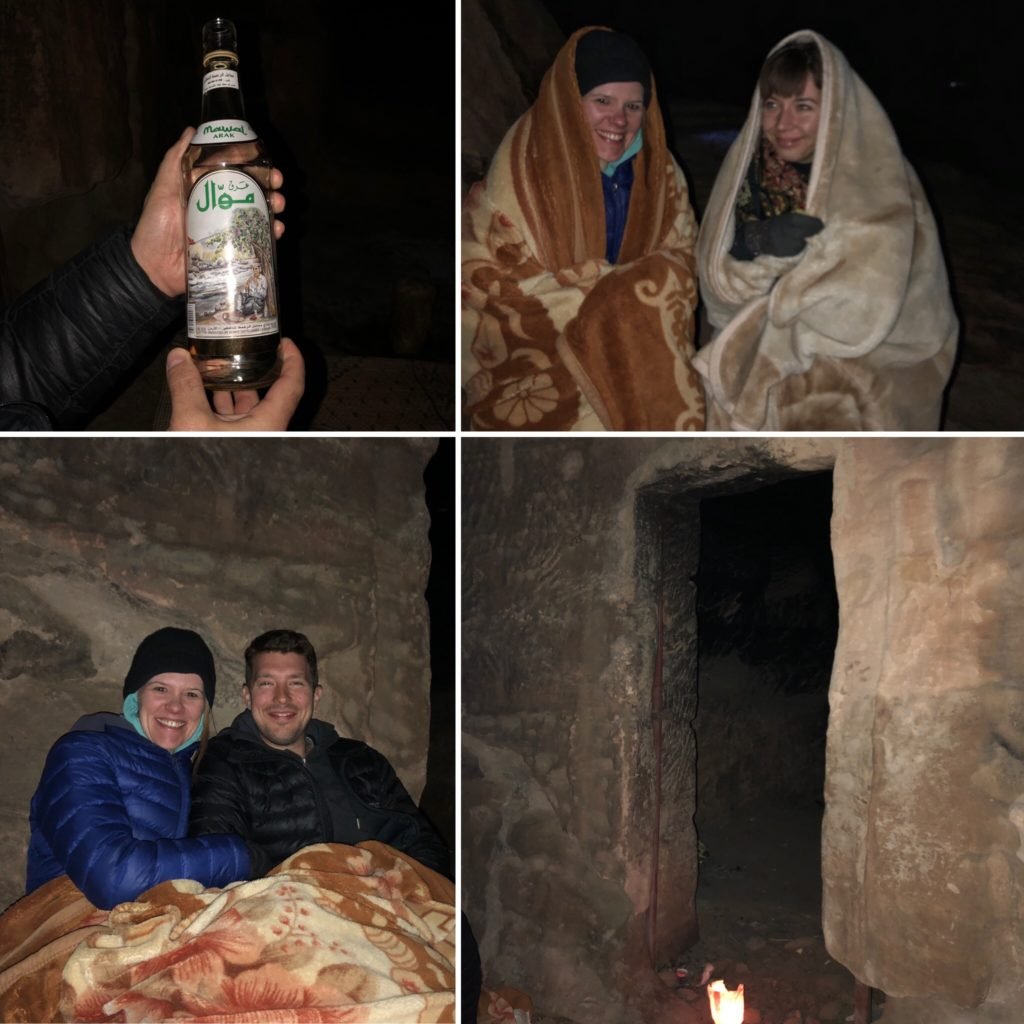
We planned to wrap up our last night in Little Petra by sleeping in a Bedouin cave we found on Airbnb. Unfortunately due to some logistical reasons, the cave sleepover, didn’t happen but we still got to have a fairly authentic Bedouin experience by having dinner at the cave in lieu of sleeping there. In order to keep warm in the upper-30’s weather, they provided us with pads to sit on, giant blankets, and even our first Jordanian made spirit (it does exist!), called Arak. It had a heavy anise flavor and was delicious… and 52%(!) ABV.
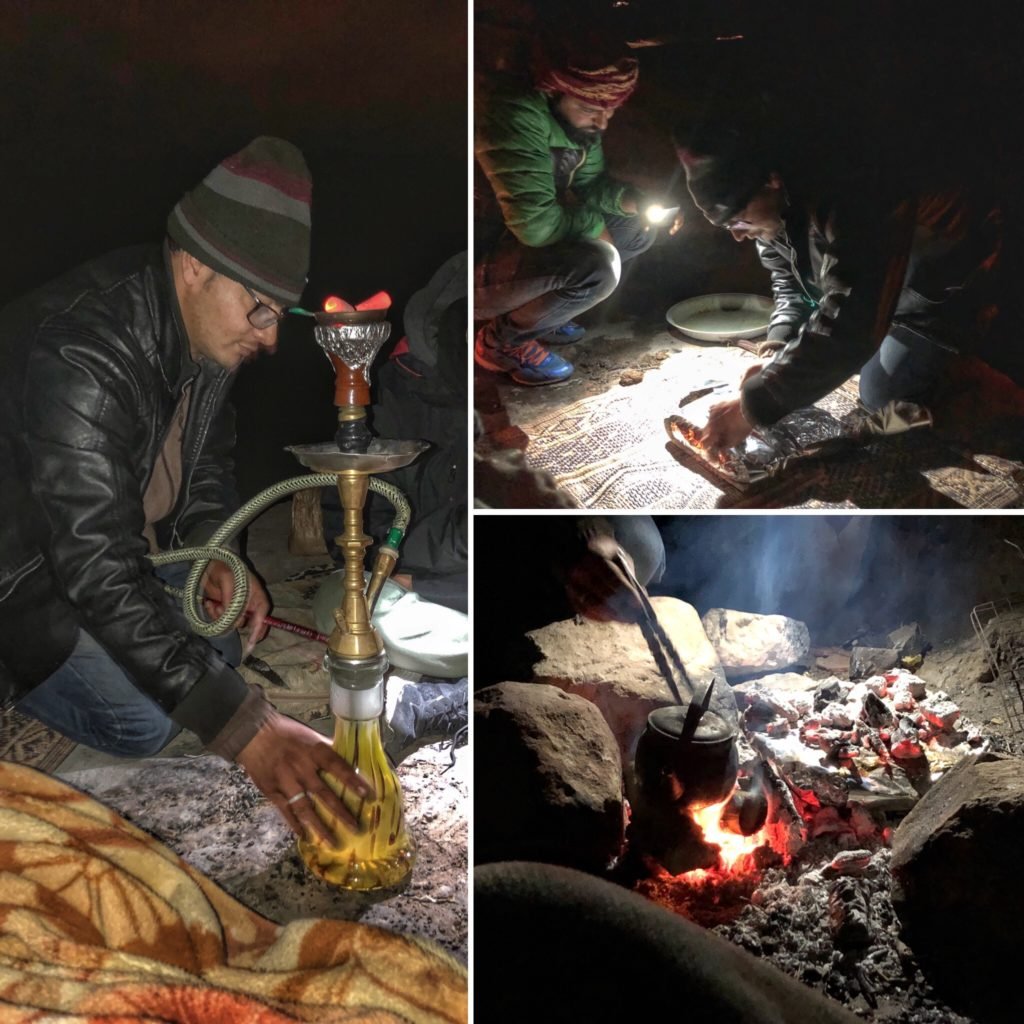
We observed as they made our dinner as they did 2000 years ago…by iPhone flashlight! They chopped all the vegetables and wrapped in foil, and tossed it on the glowing coals of the fire. While we waited about an hour, we got to imbibe in another soothing treat…our first shisha pipe with apple flavor (more commonly know as the Turkish Hookah.)
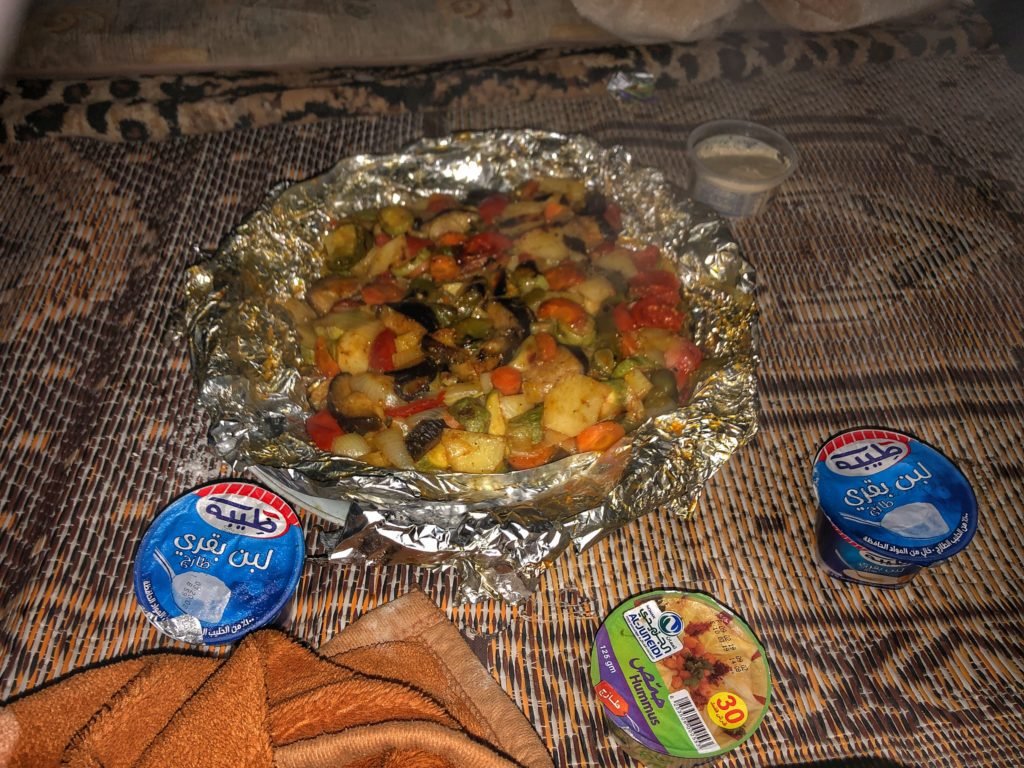
As we gazed at the most abundant glitter-popping stars above us, we scarfed our mouth-watering dinner. And don’t even think about using a fork. Everything is eaten with pita bread (using your right hand only if you wanna be PC) and dipped in hummus or yogurts. This first Bedouin desert meal was divine. In fact…Jordan is just divine. Hmm…where shall we go next?!
Next Post: Jordan 2–From Bedouins to Bikinis (Wadi Rum & Red Sea)

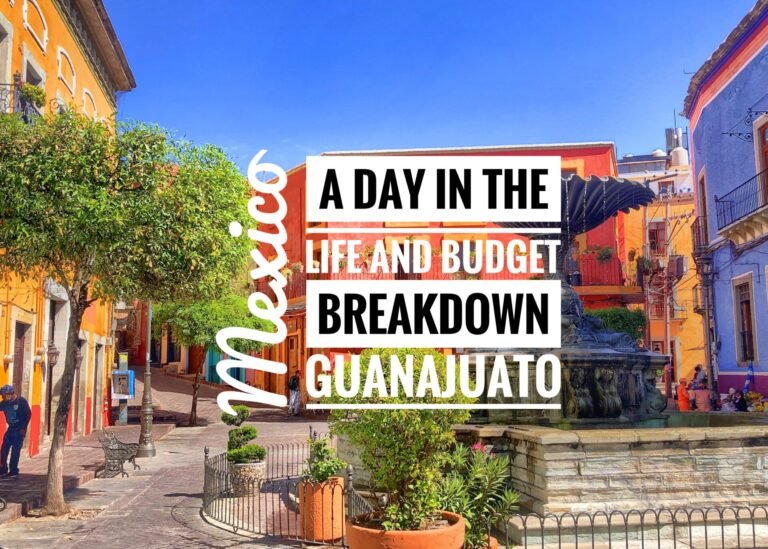

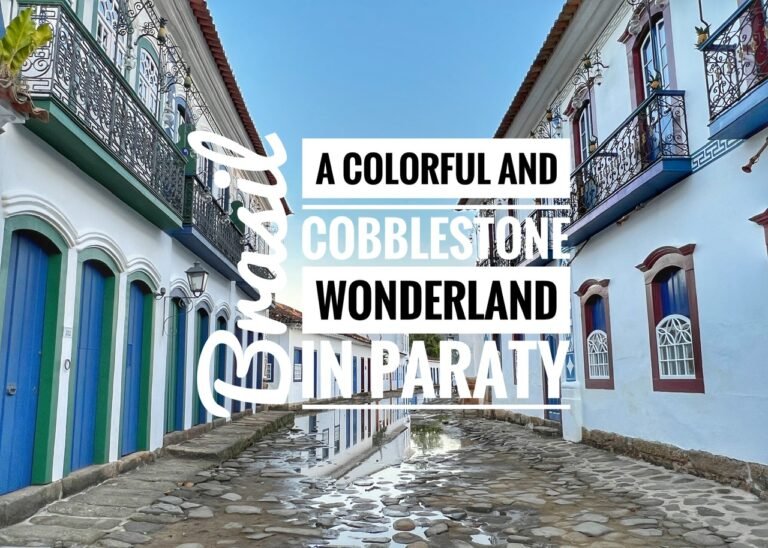
Absolutely breathtaking. Would love to go there!
They say life is not measured by the number of breaths we take, but rather by the number the moments that take our breath away. This must have been one of those moments for you two.
Amazing journeys!!!
One of our favorite quotes…couldn’t agree more! Yes, this has definitely been one of our most incredible experiences. Thanks for your comment! 🙂
The culture and landscape reminds me so much of Morocco. Adding this to our list. I look forward to visiting!!
You would definitely love Jordan…no question!